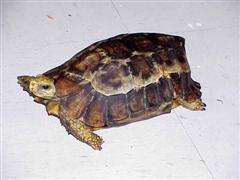Hingeback Tortoise - Home's
Forest Hingeback Tortoise, Homes Hingeback Scientific Name: Kinixys homeana
Sat, 5th July, 2025 - 9:59 pm GMT
Sponsor Ads:

Alternative Name
Forest Hingeback Tortoise, Homes Hingeback Scientific Name: Kinixys homeanaBasic Info
The Home's Hingeback Tortoise is distinguished from other Hingeback Tortoises by its shell, which is quite angular and comes to an abrupt end at the back. The Home's Hingeback Tortoise's shell is brown and its head is a lighter shade. The name "Hingeback Tortoise" comes from the hinge about three quarters of the way down the carapace. This hinge allows the tortoise to close the back of its shell completely, protecting its hind legs and tail.
Health
Specific Care Information: Relative Care Ease: Average Home's Hingeback Tortoises require a large enclosure. Ideally, this enclosure should be outdoors in an area of high humidity. The enclosure should contain enclosed spaces to hide and sleep in and a large, shallow water dish for soaking. They will soak in the dish almost daily. Tortoises are grazing animals, so the enclosure ideally should contain live edible plants. If this is not possible, they can be fed a diet of things such as dark leafy green vegetables, cucumber, squash, carrot, tomato, zucchini, green peppers, commercial box turtle or tortoise food, primate biscuits softened in water, and fruits. They should also be given meaty items such as low fat canned dog food (a premium brand) and insects a few times a week. Some hobbyists like to give calcium supplements, but with a proper diet it is generally not necessary.Habitat
Home's Hingeback Tortoise requires a great deal of humidity.Behavior
The Home's Hingeback Tortoise is also known as the Forest Hingeback Tortoise and is a subspecies of the African Hingeback Tortoise. It is native to Africa but is quite common in captivity. While it can be an easy, rewarding pet when acclimated to its new environment, many Home's Hingeback Tortoises die within a short time of entering captivity. Native to regions of high humidity, the Home's Hingeback Tortoise is a species that, while primarily terrestrial, will spend large periods soaking in warm water. They can be found in grasslands, savannahs, and similar areas. Generally speaking, they are very hardy animals; however, the Home's Hingeback Tortoise has difficulty adapting to a new environment and may have problems because of this. The Home's Hingeback Tortoise is omnivorous and primarily insectivorous, meaning while they eat both plant and animal material, the majority of their diet is insect-based. Some common foods they eat in the wild are fruit, grass, plants, slugs, millipedes, and snails.Origin
AfricaHistory
Native to Nigeria, the Ivory Coast and the Congo, Home's Hingeback Tortoise requires a great deal of humidity. If it is not given suitable living conditions, it will likely not survive. The African Hingeback Tortoises are often mistaken for Box Turtles. While the African Hingebacks only have one hinge in their shell, on the carapace, which allows them to close only the back half of the shell, Box Turtles have two hinges on the plastron that enable them to close their entire shell tightly.Common Foods
The Home's Hingeback Tortoise is omnivorous and primarily insectivorous, meaning while they eat both plant and animal material, the majority of their diet is insect-based. Some common foods they eat in the wild are fruit, grass, plants, slugs, millipedesSponsor Ads:
Disraeli was pretty close: actually, there are Lies, Damn lies, Statistics, Benchmarks, and Delivery dates.
Hingeback Tortoise - Home's
Coded by: BGID® | ALL RIGHTS RESERVED Copyright © 2000-2025
Disclaimer | Privacy | Report Errors / Contact | Credits
















